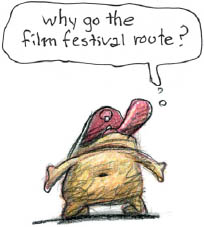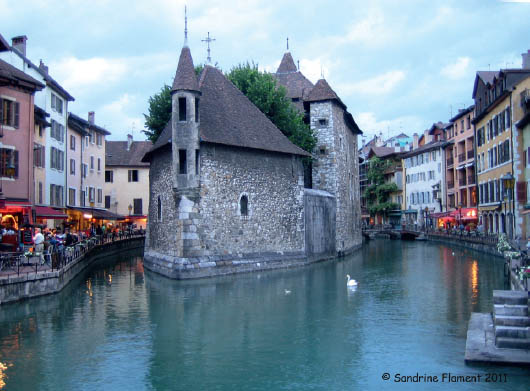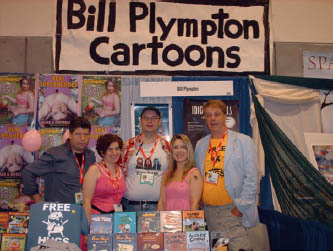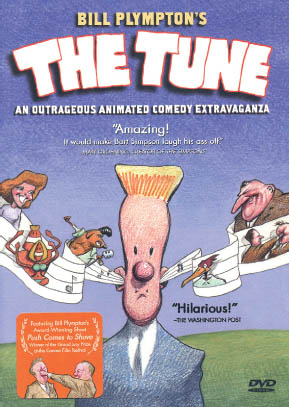SELLING YOUR FILM
In 1987, I took my first animated film, “Your Face,” to the Annecy Festival in France. I’d been there two years before with “Boomtown,” a film I directed but did not produce—but “Your Face” was a very different beast; it was funny and quirky, while “Boomtown” was serious and political.
I had no idea how “Your Face” would play to European audiences, because it was such a goofball film. Well, the European audiences loved the film. What a great relief for me—afterward, people came up to congratulate me, which was another wild shock. But the most astounding experience came when buyers approached me, offering money for the film. I had thought that the film would end up being an amusing little trifle, but with Spanish TV offering $4,000, France’s Canal Plus willing to pay $5,000, and the BBC putting up $3,000—what the hell? This film was going to make money! Suddenly I liked the festival circuit.
Many filmmakers think that once they’ve finished their film, they just have to send it off to MTV or the Cartoon Network, and they’ll be discovered. Not so fast! It just doesn’t work that way—I used to visit Abby Terkuhle’s office, back when he was in charge of MTV Animation, and he had videos of unsolicited short films stacked up to the ceiling. He told me that’s how many he would get in just one week!
Now, there was no way he could watch all of those unsolicited tapes—besides, most of them were probably crap anyway. So where did he go to see all of the great animated shorts? He went to the festivals, because their selection process would filter out all of the crappy films. In five days in an exotic locale, he could watch the crème de la crème and write the whole thing off as a business expense.
So unless you have an uncle that works for HBO or you’re sleeping with the president of the Sundance Channel, my advice to you is to go the festival route.
Here’s my list of the top ten festivals:
1. The Oscars. I know, it’s not a festival, but it is open to every filmmaker. You just have to play your film in Los Angeles County for a week or win the top prize at an Academy-approved festival, then fill out a form and your film can qualify.
Whenever the press writes about me, they usually include the phrase “Oscar-nominated,” because that’s the industry seal of approval. So it’s probably the most important event in a filmmaker’s life. And anyone can apply; it’s very democratic.
If you do get nominated (or even if your film makes the “short list”), you can get any meeting you want in Hollywood. You can get an agent, tons of press and distribution—you’ve got it made!
Plus, the Oscars are by far the best party you’ll ever go to.
2. Cannes. The Cannes Festival is like the Oscars in many ways, but it also has topless women on the beaches. The French are animation-crazy, so—as with the Oscars—you’ll get beaucoup press and sales, and you’ll get to walk the great red carpet! But please try to learn French.
3. Sundance. They now have an animation program that is very popular. For a week every January, Park City is swarming with agents looking to put a purpose to their ski trip. And there’s tons of press and distributors there, so it’s high on my to-enter list.
4. Annecy. This is my favorite festival. I go every year, regardless of whether I have a new film (I usually do). It’s held in this quaint medieval village at the foot of the beautiful French Alps. There are lovely canals flowing into the Lac d’Annecy, with picturesque swans everywhere. They have great restaurants in which you could be sitting next to Nick Park or Jan Svankmeyer or John Lasseter, or—if you’re really lucky—maybe even Bill Plympton. And everyone is very approachable and friendly.
ANNECY VILLAGE
The French fans are very passionate about films—if they don’t like your film, they’ll boo and throw balls of paper at you. But if your film is popular, they treat you like a god! Plus, the place is filled with buyers from all over the world looking for short, funny films. The Market, or MIFA, is at a nearby exclusive hotel; this is where all the deals are done.
5. The Annie Awards. The Annies, which are organized by ASIFA Hollywood, are to me the Oscars of animation. Because they take place in Los Angeles, the mecca of the animation world, it’s a super place to hang out with all of the greats in the industry. I never miss a chance to go to the Annie Awards—and winning one is extremely prestigious.
6. Clermont-Ferrand. This is another great French film festival, but it’s for shorts only. They tend to prefer live action, but they also show animation. Unlike Annecy, it’s held in a boring industrial town (they make Michelin tires there), but the people are mad for short films. They have five very large cinemas, seating up to 2,000 people each—and they are packed to the gills for every show, all day long! When do these people work? Consequently, this festival has become a huge market for short films.
Even if my film is not selected for competition, they will put it in their Bibliotheque (library) and it will make sales, even though it wasn’t screened—amazing. Be warned, though, this festival prefers more avant-garde films, so humor rarely makes it to the big screen.
7. Ottawa Animation Festival. The Canadians have a very active animation culture supported by the Canadian Film Board. They also have a very popular festival each year in Ottawa, run by Chris Robinson, whose specialty is Estonian films, and scratch-on-film movies—so you can get an idea of the kind of films they like, which are dark and experimental. But they also have a market, which has become very important for directors and producers. It’s also an especially wonderful festival for students.
8. Stuttgart Animation Festival. Another one of my favorites. It’s held in a beautiful part of the Old City next to a lovely park with lots of fountains and beer gardens. The festival is very well run, with great programs of popular Hollywood animation, plus historic programs of obscure films, European features, great parties, and also packed audiences.
9. Expression en Corto. This Mexican festival takes place in two cities, San Miguel De Allende and Guanajuato. It’s probably the largest market festival for shorts in the burgeoning Latin American market. They have a wide variety of programs, both live action and animation. They have press and buyers from all over the world—it’s truly an international festival, and I highly recommend it.
10. Sitges. Situated on a beautiful seaside town just south of Barcelona, Spain, it’s become a great market for fantasy and animated films. The food is fantastic! The location is exotic—you can swim in the ocean every morning, and the Spanish audiences are also rabid fans! Also, the festival is full of press and buyers—you’ll have a ball!
This list is for festivals that are important for business—they also have great parties and social activities, but I go primarily for business:
1. Tribeca Film Festival. Started by Robert De Niro and Jane Rosenthal after 9/11, this festival in downtown New York has become a great event in just a few short years. It’s great for finding distribution, but it’s too bad that they tend to treat the filmmakers like crap.
2. Toronto Worldwide Shorts Festival. Not to be confused with the much larger Toronto Film Festival (which doesn’t allow shorts from outside Canada), the Shorts Festival has become a very important marketplace for short films and animation.
3. Palm Springs Shorts Festival. Not to be confused with the Palm Springs International Film Festival, this festival is very well run. They have a lot of buyers and press, plus great parties—I’ve done a lot of deals through this festival, and met a lot of really great people.
4. Deauville American Film Festival. It seems like France is full of great film festivals. Another favorite is the Deauville American Film Festival—it’s located in the Normandy region. Lots of old money, beautiful beaches, and Belle Époque charm. One time after swimming in the ocean I walked through the private garden to my room in the stately hotel, and there were Tom Hanks and Steven Spielberg, just hanging out and drinking aperitifs. I would have introduced myself, but I looked like a drowned rat emerging from the seaside.
5. AFI. The American Film Institute festival is quite important in terms of programming. Running parallel to this festival is the prestigious American Film Market, so it’s possible to sell your film in both events. The festival takes place in Los Angeles, so it’s a great place to hold industry meetings.
6. Fantasia Festival. Another Canadian Festival, this one in Montreal, which attracts huge audiences. It’s particularly interested in fantasy and Asian films (hence the name), but they love animation—check it out.
7. Aspen Shorts Festival. This very well-organized festival, like Palm Springs, is one of the biggest US festivals devoted to short films. Both are very good places to pick up distribution; it’s also held in a very lovely but expensive town.
8. Göteburg Festival. This Swedish festival is like the Clermont-Ferrand of Scandinavia; it’s an old and established festival that gets tons of press and distributors.
9. Hong Kong Film Festival. If you want to get into the huge Asian market, this is the one for you. It’s a very old and well-respected festival, and press, buyers, and other festival directors come from all over—China, Korea, Japan—to see the new films, so you should check it out.
10. Puchon International Student Animation Festival (PISAF) and Seoul International Cartoon and Animation Festival. These are two Korean festivals that spotlight animation. I love Korea; they are my biggest Asian market, and they love fantasy and animation.
11. Animator Festival in Poznan. This is a real up-and-coming festival in Poland. There’s a lot of great animation coming out of Poland, and this is the place to see it.
12. Animafest Zagreb. This once-mighty festival in Croatia used to be very important, but because of war and money issues, it’s lost a lot of its luster. It’s coming back strong, though. Zagreb is a beautiful old city that holds many wonderful charms.
Festivals can be more than just places to sell your film. Following is a list of fun festivals, with great parties and beautiful scenery:
1. Woodstock Film Festival. I’ve been affiliated with this festival for about ten years, and I keep coming back because they treat the filmmakers so well. Also, it’s held in a beautiful preserved village with lots of great parties and people.
2. Florida Film Festival. Like Woodstock, they know how to treat filmmakers. Great programming and wonderful parties, with terrific ambience in the cinema and restaurant at the Enzian Theater. Check out the huge jungle mural in the Eden Bar, created by moi.
3. Monstra in Lisbon, Portugal. I had a ball there; it’s such a beautiful city. The cinema is this historic old movie palace that’s been refurbished, and the people are so nice and obsessed with animation. And it’s near the ocean, in case you want to take a swim.
4. Anima Mundi. This one takes place in beautiful Rio de Janeiro (you’ll notice a lot of my favorite festivals take place in warm climates near beaches). This festival is getting larger every year. It’s well run, with a very enthusiastic following of young film students.
5. San Sebastian Horror Festival. Not to be confused with the regular San Sebastian Film Festival. Held in another beautiful Spanish town in Basque country, on the Atlantic coast, with fabulous food and great parties. They love weird animated films, so I felt right at home here.
6. Martha’s Vineyard Film Festival. A gem of a festival, in a beautiful seaside village. You might run into President Obama there.
7. KROK. A crazy Russian festival that takes place on a boat. The films never start on time, the projection is always haphazard, and the food is not the best, but you can drink vodka, party, and sing every night as the giant ship cruises past the lovely Ukrainian countryside. Believe me, it’s an experience you’ll never forget.
8. Telluride Film Festival. One of the most prestigious festivals in the world. On top of the beautiful Rocky Mountains, it literally takes your breath away (you’re over a mile high). The best programming in the world, and all of the stars are there. I’ve had a tough time getting my films accepted—twice in 25 years—but if you get in, it’s worth it. The best parties ever, and the press is frowned upon—it’s not a market festival.
9. Ashland Film Festival. Situated in the gorgeous Southern Oregon Valley, this historic town is a wonderful place for a film festival. Great programming and terrific parties—you’ll love it!
10. ASIFA New York. I guess I have a fondness for this festival, because it’s right in my own backyard, and everyone I know in the New York animation society is usually there. And the party afterward is fantastic, because you get to mingle with all of the animators! And it’s free!
If you remember my earliest experience with ASIFA and “Your Face” from previous chapters, then you know the special fondness I have for that organization.
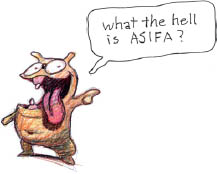
I’d like to explain about ASIFA, because it was through that organization that I got my start. ASIFA is a French acronym that stands for Association Internationale du Film d’Animation. It was started in the 1960s and has grown to become truly international, with chapters on every continent (except Antarctica). The United States alone has around ten active chapters.
The largest is in Los Angeles, simply because there is such a huge animation industry there. And it’s there that they hold the prestigious Annie Awards (the Oscars of animation).
The New York chapter is geared more toward independent animation, simply because New York has the largest collection of indie animators in the world. We gather every month to watch films or listen to lectures. But for me, the most important aspect of ASIFA is as a resource for information about the animation business.
ME, JERRY BECK, AND DAN O’SHANNON ON THE ANNIE AWARDS RED CARPET
Where can I find a cheap animation table? Who are some good voice-over talents? What’s the best lab to make prints? Where should I go to sell my film? Which are the coolest film festivals? All of these questions, and more, can be answered through ASIFA.
Also, as a social organization, it’s a great group of people to hang out with, party, and talk about what exciting new films are in production. I heartily recommend that you join an ASIFA chapter in your area. It will give you tons of inspiration to get on with your next film.
Another big market for my films is the comic conventions—these places are not great for finding distributors, but they are great places for making press and industry connections. Also, I usually make a few bucks selling DVDs and art. Here are my favorites:
1. San Diego Comic-Con. The granddaddy of them all. They have a small film festival within the convention, and I enter every year, though I’ve never won—how frustrating! But San Diego is still a great place to see everyone from Hollywood.
KEVIN, ALEXIA, JOHN, LUCY SPAIN, AND ME AT THE SAN DIEGO COMIC-CON
2. New York Comic-Con. This is a relatively new event, but it’s growing fast. People say that in a few years, it may compare to San Diego. The price of a booth is a lot more affordable than in San Diego—and for me, it’s certainly more convenient.
3. MoCCA. The Museum of Comic and Cartoon Art hosts an Art Festival each year, and this event is more for the underground and independent comics and graphic novels. So it actually has a lot of my fans there—I love this event, and I’ll occasionally do a panel there.
There are dozens of great comic conventions around America—also check out the one in Angouleme, France. Many of them support animation, so be sure to go online and find out which ones have animation sections.
How to Find the Right Festival
The Internet is a great place to discover thousands of festivals—there’s even a film festival in Sweden that focuses on pain—so if you have a film that’s all about pain, send it to Sweden. Check out the website Without A Box for more information on festivals.
But be careful: a lot of them charge submission fees. The European festivals, because they’re state-sponsored, are usually free to enter; most of the US festivals charge a nominal fee of $15 to $40. Some charge more, up to $100—those I would strongly encourage to avoid because they’re ripoffs.
The good news is that if you’ve won a prize before at these festivals, or if they show a lot of your films, sometimes, if you ask real nicely, you might be able to get a waiver of the entry fee.
And if you have a feature film that’s popular and getting a lot of publicity, sometimes it’s even possible to get a screening fee from the festivals—I’ve done it a few times. I sometimes feel awkward asking for a screening fee, because I should be happy to have my film in any festival, but you have to remember that they charge the public admission to see the film, so it seems only fair.

Okay, let’s say you get accepted to a big important festival like Sundance. This is a festival where a lot of films are picked up for distribution, and there will be tons of press. How do you prepare for this intense week of marketing?
First, I think if you have a feature playing at the festival, it’s good to have a press agent. There are a lot of press agents around; just ask other filmmakers whom they recommend.
It’s tough to know how much to pay a press agent—in my experience, anywhere from $1,000 to $10,000 is the proper range—but just remember that if you pay on the low end of the scale, they’ll probably be handling other films along with yours, and those other films might get a lot more attention.
To help the press agent, I always put together some press packets, filled with:
• A postcard with an intriguing image on the front and showing on the back the cast, credits, a synopsis, screening times and places, and of course contact information. These cards are invaluable; I print up about 2,000 and give them to anyone I talk to so they can tell their friends about the screening.
• A more complete synopsis, plus some interesting anecdotes or background stories about the film’s production. This additional material could be some information about famous people whose voices are in the film or any notable musicians on the soundtrack.
• A complete list of the credits; the reviewers absolutely have to h ave this. A short clip or promotional trailer from the film on DVD is great, too, along with some stills.
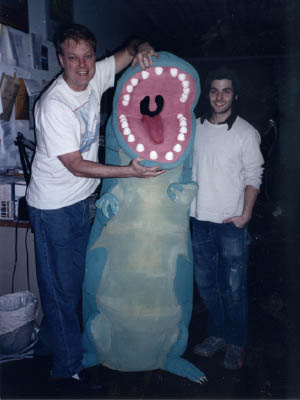
ME WITH LIFE-SIZE MUTANT ALIENS PROMOTIONAL MONSTER COSTUME AND BRIAN HAIMES, THE SUIT’S CREATOR
Posters are important, too—you can use the same image from the postcard so that people won’t get confused or think there are two films with the same name.
Finally, it would be great to have some swag, or gifts, to hand out—some that I’ve used to great effect are film strips—often when the lab makes a film print, the color could be off or the sound could be out of sync. I ask for these rejected prints, and then cut them up into little sections, then put those in fancy tiny envelopes. I autograph the front and give them away—you’d be surprised how popular they are.
You can also get these tiny film viewers, little plastic ones with a clear window at one end. I cut up the old or damaged film prints and put single frames of film inside (it’s best if the scene has some nudity or violence—I have no idea why) and give those away. The promotional companies that make the viewers can even sometimes add the name of the film on the side—people love that stuff.
But the most effective giveaway is for me to make a drawing of one of my star characters on the back of the postcards I hand out—people go batshit crazy for that!
Along with the press agent, the most important person to have on your side at these events is a sales agent.
When I took my first feature film The Tune to Sundance, I was very lucky to have the great John Pierson representing my film for distribution. At that time, he was famous for repping Spike Lee, Richard Linklater, and then later Kevin Smith.
It was amazing for me to find out how the business worked—The Tune got huge ovations and lots of great reviews and had tons of fans, but we never got the kind of offers that we were hoping for. In fact, we had only one distributor interested in handling the film, the newbie October Films—and they were so new that they had no money to offer as an advance. I think no one at that time believed there was an audience for indie animation.
What was I to do? Put the film on the shelf and forget about it? Distribute it myself? Or take their offer and risk not making a dime?
Well, obviously we took October Films’ offer, such as it was. The film did all right, but I made absolutely no money from October or from TV sales or from the video release. It was only after October’s contract ran out, and the rights reverted back to me, that I was able to make some money in the United States on that film.
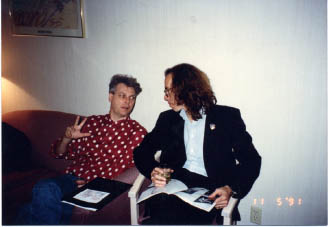
ME AND JOHN PIERSON, MEETING BEFORE THE L.A. PREMIERE OF THE TUNE
The other distribution deal I got was from Lionsgate Films for my second animated feature, I Married a Strange Person. This deal was negotiated by Catherine Branscome, my sales agent, and it was a much sweeter deal than October’s. We got just under a six-figure advance; plus, the film did so well that I actually got royalties. Imagine that: royalties!
So, it does pay to have a sales rep or agent with you at the festivals. Their usual cut is between 10 percent to 30 percent of the deal, depending on what your relationship is.
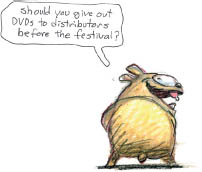
This is a very difficult question; I still don’t have a definitive answer, but let me give you my thoughts.
The prevailing philosophy is absolutely no! Don’t let any press or distributors see the film before the world premiere; otherwise, you’ll lose your excitement factor.
You want all the buyers there at your premiere screening in order to build up a buzz and bring the distribution to a frenzied buying spree. However, what happens if you get a very sullen audience that day or there’s a blizzard outside and only a few people show up? (This is what happened to me with Mutant Aliens). Then the film bombs! Big mistake.
You sometimes hear about a lot of films getting picked up before the festival. How do the buyers get their screeners? What’s going on? Often, a filmmaker or a sales agent will have a cozy relationship with a distributor, and they may show them the film at the editing stage in order to get the distributor excited and to secure an advance of some funds to finish the film. This happens all the time, so letting people see the film before the screening can be useful, and there really is no right or wrong way. Both methods are a gamble, but isn’t the film business always a gamble?
I’ve heard stories—I don’t know if they’re true—that aggressive distributors curry favors with the heads of the festivals in order to get an insider’s look at the hot films before the selection is announced.
Back in 1987, I was invited to go to the Telluride Film Festival with my animated short “How to Kiss.” It was a huge thrill for me, seeing all these great films and meeting all these great filmmakers, such as Chuck Jones. But the most amazing event happened after the premiere of Louis Malle’s film Au Revoir Les Enfants.
We all went out to the Sheridan Opera House restaurant after the screening, and at each small table was a group of acquisition heads from independent film companies like Miramax and New Line Cinema—there were about seven tables full of buyers. Mr. Malle entered with his agent, grabbed an empty table, and each one of the distributors patiently awaited their turn to be invited to sit at his table and make their offer to the hot director.
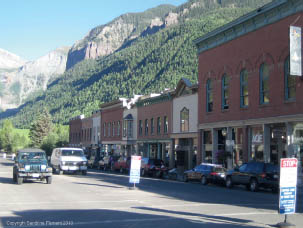
MAIN STREET, TELLURIDE, COLORADO (PHOTO BY SANDRINE FLAMENT)
As I sat at the bar, I thought, “Damn, that’s what I want! I want to make a film that has the buyers lining up to meet with me.” Well, I still haven’t done that—but there’s still time. I’m still waiting at my table. Unfortunately, it’s an empty restaurant and no one’s rushing to join me for dinner.
Let’s assume that you’ve made a great film, and you’ve got a distributor hot to handle your film—what’s next? Hopefully, your sales rep can take over for you, and make the deal … not so fast there, young Orson Welles! You’ve got to define what you want.
Before I talk about contracts, I need to make a little disclaimer—I’m not a lawyer, I don’t like contracts, and it’s probably better for you to get a lawyer (or a more thorough book on the subject) that specializes in the details of entertainment law—but I can give you a few of the important points that I look for:
1. GTFM. Get The Friggin’ Money. Try to get money up front. It’s much harder to get companies to pay you after the film has opened.
2. Try to get a gross participation, not net. In other words, you should get some money (royalties) before the distributor starts deducting all of their expenses—prints, advertising, travel, hotel, printing, and so on (good luck on this one).
3. Be sure there’s a performance clause in there stating that if they don’t release the film, after a prescribed time (one year, for example) all rights revert back to you—you don’t want the film gathering dust on a lonely shelf somewhere.
4. Try to get a commitment on a release budget so that you know that the feature will get its proper release. Say, anywhere from $30,000 to $1 million.
5. Try to limit the territory so that you can get rights to sell to the lucrative overseas markets.

Proceed very carefully—there are dozens of distribution companies out there. When you start working the festival circuit, you’ll become familiar with them. They’re at all of the parties, on panels, at the screenings. Be friendly and make connections; they’re very important people. Buy them drinks and give them DVDs.
Also, read the trades, like Variety, Hollywood Reporter, Cartoon Brew, and AWN—they have all of the news about indie distributors. Keep a list of the films you like and who distributed them. Find out who the acquisition people are for those companies, then take their cards and put their contact information in your address book.
I’ve got a couple of gripes about dealing with distributors.
It’s a common principle that you never reveal the budget of your film. I don’t know how many panels I’ve gone to with indie directors blabbing on about how great their film is—then, during the Q&A, someone always asks about the budget, which of course is what everyone wants to know. The director either says that he doesn’t know, which of course is bullshit, or that he can’t say—why the hell not?
The usual answer is that the distributors supposedly base their advance offers on how big the budget is. Now, I know a lot of acquisition people, and I’ve never heard anyone say that the budget determines the advance. It’s the quality and sales potential of the film that determines the advance—if there is an advance.
Example #1: The Blair Witch Project, supposedly made for just $10,000, got a huge advance. The distributor thought it could do well theatrically, because of all the great buzz and publicity.
By contrast, there are countless other “indie films” with budgets of $10 million to $20 million that don’t get anything close to that for an advance. So I see no reason why filmmakers can’t be honest and tell everyone what a film cost to make. Some films, like those from Robert Rodriguez (El Mariachi), are so cheap that they promote the films by mentioning how low the budget was.
I’m always proud to talk about my budgets. It’s very instructive to see what kind of money goes into making each different film. And I’ll be honest with you: only three of my features have made their costs back, as of this writing: The Tune, I Married a Strange Person, and Idiots and Angels. See, that wasn’t too difficult to say.
My other peeve is distributors’ reluctance to acquire my films. It’s a real mystery to me, because when the distributors see my films, they always have the same lame excuse: “It’s not for us.” What does that mean? I’m left to hypothesize about what “It’s not for us” means.
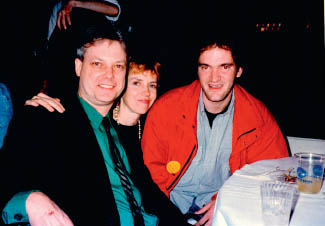
ME AND MAUREEN MCELHERON (THE TUNE) AND QUENTIN TARANTINO (RESERVOIR DOGS) AT SUNDANCE (1992)
Is it because the film is animated? In 2010, five of the top ten grossing films were animated, and another three were very special effects–heavy films. So I know that people love animation.
Is it because the film has adult ideas, for an adult audience? The great Quentin Tarantino essentially makes live-action cartoons for adults, and they do very well at the box office.
Is it because I’ve taken this pristine art form, created by Walt Disney for children, and somehow sullied its good name? Is animation only an art form for kids—am I the “dirty old man” of cartoons?
Is it because my stories are not good? But people come out of the theater, after watching Idiots and Angels, raving about the story and the characters—and all of the reviews remarked about how interesting the story was.
Is it because my films are hand-drawn, not CGI? All of the great Disney classics were drawn by hand, and 90 percent of all the animation on TV is hand-drawn.
Or is it because I’m an independent? I don’t work out of a big Hollywood studio with banks of producers, agents, and bureaucrats. Does that scare them? Do they need me to hire hundreds of artists and writers before they’re comfortable selling the film to an audience? Isn’t the quality of the picture the bottom line for the commercial value of a film?
It’s my strong belief that the audience wants to see something different—something fresh. They want new ideas and new visions. They’re hungering for a new voice in the film business, and I think I’m one of the many new storytellers. Why can’t the distributors see that?

